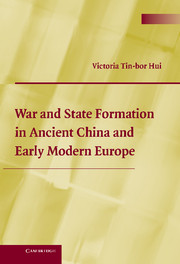Book contents
- Frontmatter
- Contents
- List of Tables and Maps
- Acknowledgments
- 1 A Dynamic Theory of World Politics
- 2 The Dynamics of International Politics in Ancient China
- 3 Rethinking the Dynamics of International Politics in Early Modern Europe
- 4 The Dynamics of State Formation and Transformation
- 5 Conclusion and Implications
- APPENDIXES
- Bibliography
- Index
2 - The Dynamics of International Politics in Ancient China
Published online by Cambridge University Press: 02 February 2010
- Frontmatter
- Contents
- List of Tables and Maps
- Acknowledgments
- 1 A Dynamic Theory of World Politics
- 2 The Dynamics of International Politics in Ancient China
- 3 Rethinking the Dynamics of International Politics in Early Modern Europe
- 4 The Dynamics of State Formation and Transformation
- 5 Conclusion and Implications
- APPENDIXES
- Bibliography
- Index
Summary
Kenneth Waltz expects “substantive and stylistic characteristics” in ancient China to be similar to those in early modern Europe. He is correct. The Eurocentric logic of balancing – which encompasses the mechanisms of balance of power and rising costs of expansion – was predominant from the onset of system formation in 656 bc to the turn of the third century bc. For more than three centuries, attempts at domination were made and checked, ambitious hegemons rose and fell, balancing as a foreign policy was pursued, and balances as roughly equal distribution of relative capabilities occurred at various times. The length of this period of sustained stability was comparable to the whole span of the early modern period. However, from the midfourth century bc on, the Warring States system became increasingly unstable. States one after another intensified their pursuit of the logic of domination – self-strengthening reforms, divide-and-conquer strategies, and cunning and brutish stratagems. Most notably, the state of Qin developed the capacity for direct rule and moved toward total mobilization for war. Qin also shrewdly complemented its increased relative capability with ruthless strategies and stratagems on both the diplomatic and military fronts. From 356 to the third century bc, Qin gradually rose from relative weakness to hegemony and then to domination. Qin eventually achieved universal domination in the ancient Chinese world in 221 bc.
- Type
- Chapter
- Information
- Publisher: Cambridge University PressPrint publication year: 2005
- 1
- Cited by



